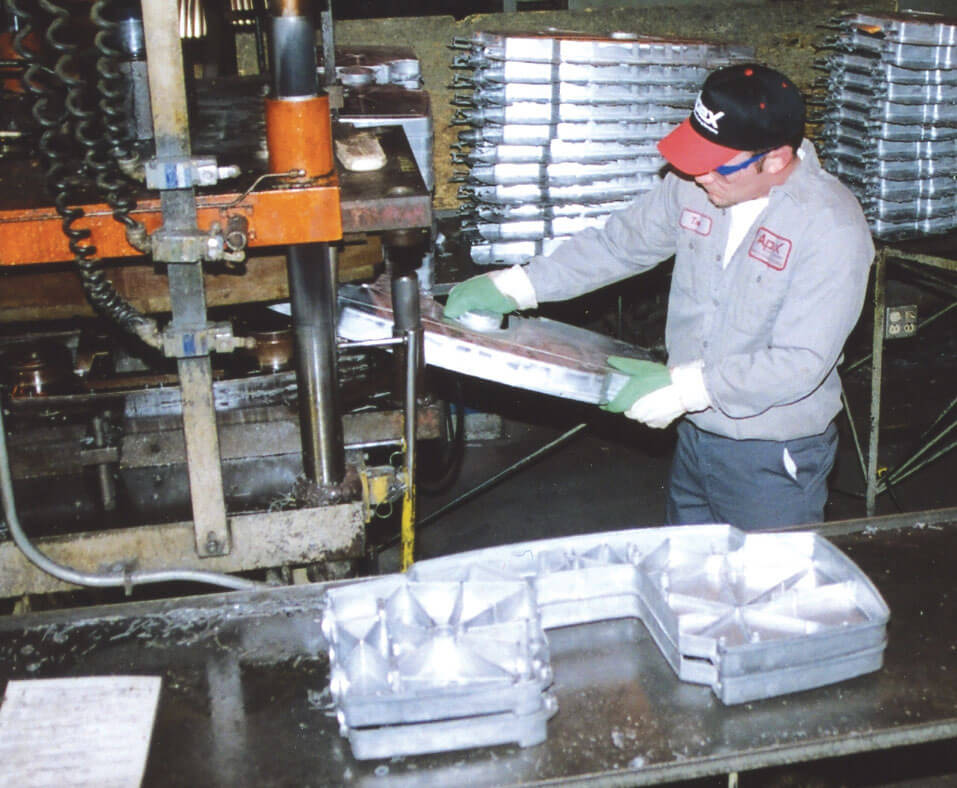Aluminum Castings Company Fundamentals Explained
9 Easy Facts About Aluminum Castings Company Described
Table of ContentsThe 2-Minute Rule for Aluminum Castings CompanyAn Unbiased View of Aluminum Castings CompanyThe Best Strategy To Use For Aluminum Castings CompanyIndicators on Aluminum Castings Company You Need To KnowTop Guidelines Of Aluminum Castings CompanyAbout Aluminum Castings CompanyThe 45-Second Trick For Aluminum Castings CompanyThe Definitive Guide to Aluminum Castings Company
There are 2 main types of die casting utilized in the light weight aluminum casting market: warm chamber pass away spreading and chilly chamber pass away spreading. The main distinction in between these techniques is just how the molten steel is supplied to the mold and mildew. In warm chamber pass away casting, frequently made use of for reduced melting point steels, the fusion is straight connected to the maker, and a bettor requires the material via a gooseneck right into the die cavity.
The Single Strategy To Use For Aluminum Castings Company
In these techniques, the mold is intentionally destroyed or escaped in order to remove the ended up light weight aluminum spreading. Typical processes under the category of expendable mold casting include (financial investment spreading),,, and investment spreading. When producing custom-made aluminum components using expendable mold and mildews, producers put liquified aluminum or light weight aluminum alloys right into the mold, which is after that broken apart to launch the solidified steel part.
The is just one of the earliest and most favored forms of light weight aluminum casting. It entails compacting specialty foundry sand, usually strengthened with clay or resin, around a specifically crafted reusable pattern that figures out the shape and interior information of the finished aluminum product. The pattern system integrates risers and vents to manage the circulation of molten steel and to avoid casting flaws such as shrinkage porosity.
Some Known Questions About Aluminum Castings Company.

This mold and mildew is then preheated previous to the putting of liquified aluminum or light weight aluminum alloy. As the steel fills up the shell, it captures the intricate information and great surface area coating of the mold and mildew. When cooled, the ceramic is mechanically or chemically escaped, enabling the removal and splitting up of specific actors components.
3 Simple Techniques For Aluminum Castings Company
Irreversible mold and mildew spreading uses recyclable metal mold and mildews and is suitable for mass production with constant quality and less waste. Expendable mold and mildew spreading utilizes single-use molds, like sand or foam, supplying style flexibility and reduced tooling expenses for prototypes or short runs. Pass away casting is best for producing high quantities of aluminum parts that call for tight resistances, fine information, and smooth surface areas.
The Toshiba Machine DC-J Collection consists of pass away casting devices ideal for light weight aluminum. Known for their durable building and construction and high shot performance, these equipments ensure reliable and exact casting (Aluminum Castings).

While light weight aluminum can be used in its pure form, it is commonly alloyed with various other metals to improve its properties or the homes of the various other steels. These alloys use boosted performance for various applications. Aluminum alloys are categorized right into eight series, numbered from one to eight. The very first digit(s) of the number suggest the main alloying element combined with aluminum.
Not known Facts About Aluminum Castings Company
This alloying improves the toughness and firmness of aluminum yet decreases its ductility and corrosion resistance. The 2000 collection alloys are testing to weld yet can be warm dealt with to boost their properties. The 3000 collection alloys are largely alloyed with manganese. This combination boosts corrosion resistance while giving moderate strength.
Furthermore, it features high ductility and a really smooth completed surface. The 4000 series alloys are alloyed with silicon, which lowers the melting factor and enhances fluidity. This makes it a prominent option for casting, as it is simple to create in its molten state. The 4000 collection is likewise commonly utilized as a filler for welding and brazing applications.
Aluminum Castings Company Fundamentals Explained
This collection is identified as a high-strength alloy, specifically suited for sheet and plate applications due to its outstanding weldability. Its resistance to rust from acids and alkalis makes it suitable for usage in harsh and hostile settings (Aluminum Melting and Casting). The 6000 series alloys are alloyed with both magnesium and silicon, giving an equilibrium of toughness, mechanical residential or commercial properties, and corrosion resistance
Processing the 6000 series needs specialized and innovative tools, which can be intricate and costly. Nonetheless, this collection is understood for its excellent corrosion and oxidation resistance, as well as its ease of layer, therapy, and workability. The 7000 collection light weight aluminum alloys are the best and most sturdy amongst light weight aluminum kinds, with stamina comparable to around two-thirds of industrial-grade A3 steel.
Aluminum Castings Company for Dummies
Zinc is the main alloying element in the 7000 series, boosting the solidity of the aluminum, also though zinc's firmness resembles that of light weight aluminum on the Mohs scale. The 8000 series aluminum alloys are mainly alloyed with tin, along with tiny quantities of copper and nickel (Aluminum Castings). While these alloys supply reduced strength contrasted to various other special info collection, they excel in machinability and put on resistance
Aluminum cast heatsinks are electrically conductive, allowing them to be grounded properly. They are frequently cast with integrated functions that minimize the demand for secondary procedures, such as additional machining or setting up, resulting in further price financial savings. Light weight aluminum spreading is frequently utilized to manufacture brackets for both heavy-duty industrial devices and household home appliances.
What Does Aluminum Castings Company Do?
The single-piece building of light weight aluminum brackets enhances their strength and sturdiness, minimizing the probability of failure. If holes are needed, they can be included directly in the spreading mold, decreasing the need for post-production finishing (https://pagespeed.web.dev/analysis/https-aluminumcastingscorp-com/xweo8i1o9t?form_factor=mobile). Makers have increasingly taken on light weight aluminum spreading for golf equipment due to its resilience, stability, and convenience in shaping